How to identify and eliminate a leak in the radiator. causes
Over time, even the most durable battery will wear out, and in the case of centralized heating, this process may be accelerated due to poor-quality coolant. The risk of leakage increases, so the ability to quickly eliminate the leak will definitely not be superfluous.

Causes of leakage
At first glance, a massive cast iron radiator seems very durable and reliable, but in fact there are enough weak spots. The coolant can start to leak through the joints (the most common option), the supply pipe can leak, damage to the radiator itself can also cause leaks.
Note! Cast iron is a rather fragile material, so even a strong blow can cause leaks. The price of repair in this case is equal to the cost of a new radiator.
There are several common types of leaks:
- at the junction of the battery with the inlet and outlet pipes, as a rule, the problem can be solved by going through the joint and using FUM tape or any other type of winding for greater tightness. Of course, if the pipe has rusted through, then the problem is not so easy to solve;
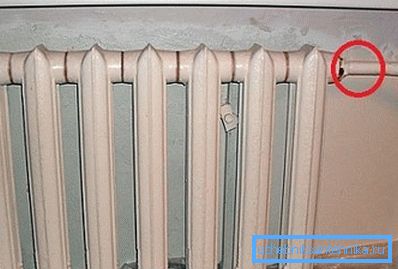
- problem with the joint sections of the battery itself;
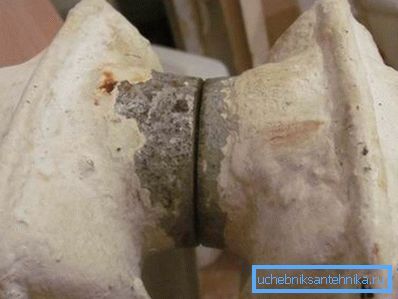
- leakage may occur due to damage to the metal of the radiator.
As for the causes of this malfunction, there may be several of them: a sharp increase in pressure in the system, stress concentrations occurring in the metal, negligence in installing batteries, and the age of radiators should not be discounted. Most often, all these factors act in a complex, so the question of why the radiator flows includes all the reasons listed.
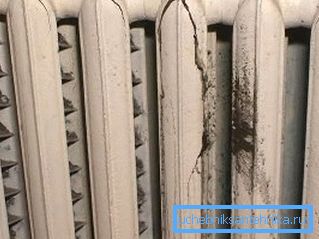
How to determine the flow
In winter, troubleshooting will not cause much trouble. Water will either leak into the problem area and drip onto the floor, or (in the event of a serious breakdown) stream. In any case, not to notice it will be difficult, the house will dramatically increase the level of humidity.
But it is better not to take matters to extremes and even before the start of the heating season to do battery testing, it is especially important to do this if radiators were installed a few decades ago.
There are several solutions to the issue of how to check for a radiator leak:
- the simplest is to simply fill the battery with water, leave it for a while, and then see if there are any wet spots under it;
Note! Such a method is imperfect, pressure is created in the heating system during operation, and with simple filling of the battery with water this does not occur.
- There is another diagnostic option - connect the battery to the water supply and observe the joints (they need to be missed with soap). If there is a leakage, air will come out of the battery in this place and bubbles will be noticeable;

- Well, the easiest way to solve the problem of how to find a leak is just to be at home when pressure testing will be carried out. At the same time, an increased pressure is supplied to the system just in order for the residents to check the batteries for leakage;
- As a solution to the question of how to determine a radiator leak, some advise to lower the radiator into the water and create increased pressure in it, the smallest air bubbles will be noticeable in the water, so that not a single problem spot will be unnoticed.
How to fix the flow yourself
Despite all the checks before the heating season, there is still the risk of a leak in winter. Only experts can finally eliminate this problem, but it is quite possible to temporarily patch up the problem area with your own hands. This will keep the furniture and other things in the house until the specialists do the repair.
How to behave in an emergency
Well, if the water flows out weakly, dripping in, in this case, simply substitute the basin and call the plumbers. Much worse, when the water is jetting out, considering the temperature of the coolant, it is not always possible to approach the battery.
The instruction in this case will look like this:
- first you just need to throw a thick, dense fabric straight into the place of the leak. This will not stop the flow of water, but at least the risk of getting a portion of boiling water will decrease dramatically;
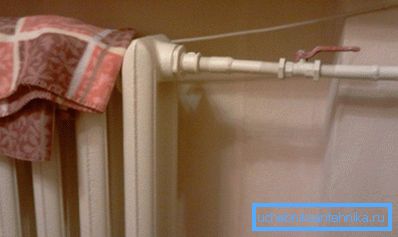
- then you urgently need to block the flow of coolant to the radiator. This can be done in several ways: if there is a bypass, then simply turn the 2 ball valves and the water will bypass the battery, but if there is no bypass, you will have to shut off the water supply to the riser, that is, the whole staircase will be left without heating for a while;

Note! The necessary crane can be found on the main pipe. Usually it is located at the entrance to the basement.
- in any case, after the adoption of emergency measures should contact the specialists. Independently serious battery rush does not eliminate.
Elimination of leaks with improvised means
The simplest remedy for eliminating radiator leaks is an ordinary bolt, with its help you can temporarily get rid of a leak (only if water does not flow out through the joint). In this case, the problematic place on the battery is drilled with a drill, the diameter of which is slightly smaller than the diameter of the bolt, then it is simply screwed into the metal.
Another way to repair a leak is to use a homemade bandage. For this you will need: ordinary gauze, an astringent (suitable gypsum or alabaster, as well as cement). In a small container, you need to prepare a solution from a binder with water and soak the bandage with the resulting solution.

Then the gauze tightly wraps around the leakage several times. The solution quickly hardens and get a waterproof bandage.
Note! Used binder depends on whether it was possible to block the water. If so, you can use cement, but it will harden for a long time. If not, then alabaster is suitable, which will harden in seconds and is not afraid of water.
Also, the question of how to remove a radiator leak can be solved with the help of ordinary epoxy or other moisture-resistant glue. The principle is the same - we saturate the fabric with glue and tightly wrap the problem area. This allows you to eliminate leakage even in difficult places, where the usual bandage will not work.
Adhesives and sealants
On sale you can find a miracle remedy - anti-leaking radiator, such compounds are used to repair leaks of automotive radiators. When it is added to water, small gaps in the metal simply boil; if on top you go with a heat-resistant sealant, then there should be no problems.

But to consider them for the heating battery does not make sense, with centralized heating it will not be possible to add to the water, and in private heating systems there may be problems with the circulating pump. So liquid to eliminate radiator leaks should not be considered as a suitable tool.
However, there is a sealant - stop-flow for the radiator, such compositions are sold in stores and can be kept at home in case of a force majeure situation.
Such sealants can be produced in 2 types:
- in a sealed package, polymerization occurs during the oxidation of the composition (that is, upon contact of the mixture with air);
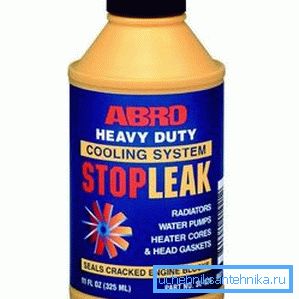
- 2-component means, polymerization occurs after mixing the base with a hardener.
To solve the problem of how to repair a radiator and eliminate a leak, it is enough just to rub the sealant into the leak. It hardens quickly, so after a couple of minutes there will be a result, if the flow is small, the radiator can last even until the end of the heating season, but it is better not to delay its replacement.
Repair with clamp
In order for the question of what to do if a heating radiator does not turn into a serious problem, it is recommended to keep a hose clamp for emergency pipe patching in stock. This simplest device looks like a rubber cuff, which is put on the tube, and then tightly crimped over the entire contact area. The created pressure is quite enough so that not a single drop of water leaks.
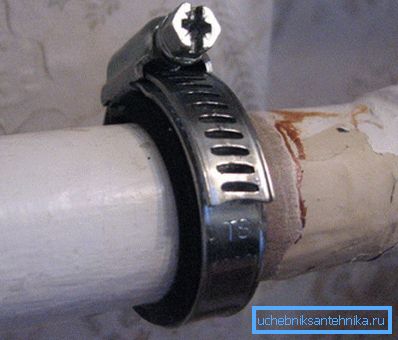
You can make a homemade analogue - you will need a piece of soft rubber and ordinary wire. Wrap a problem area with rubber, and fix the patch in place with a wire.
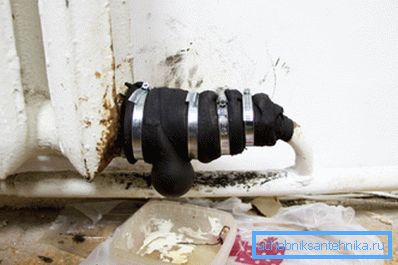
So, it is possible to solve the question of how to eliminate a radiator leak with improvised means, and special skills will not be needed.
Summarizing
Leaking in the battery is an extremely unpleasant phenomenon, moreover it occurs, as a rule, at the height of the heating season. Fortunately, there are many ways to cope with the leakage on their own in a fairly short time. The only thing to be remembered is that the proposed repair methods are temporary, that is, you have to contact the specialists.
The video in this article shows an example of eliminating leaks using a polymer repair compound.